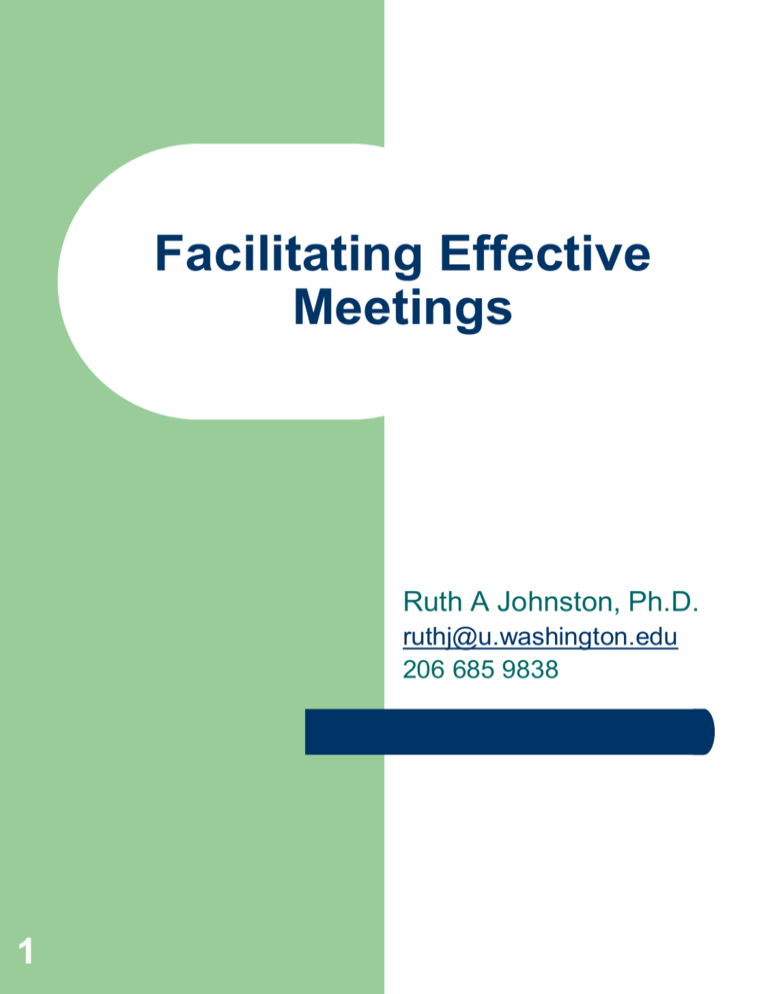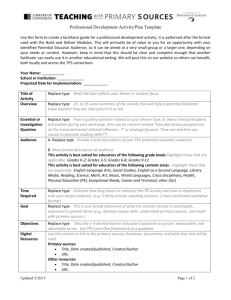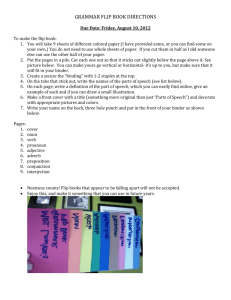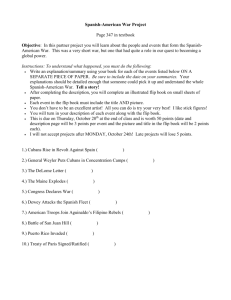Facilitating Effective Meetings
advertisement

Facilitating Effective Meetings Ruth A Johnston, Ph.D. ruthj@u.washington.edu 206 685 9838 1 What Makes for a Good Meeting? Brainstorm a list of characteristics. 2 Types of Meetings What kinds of meetings do you attend? 3 Information sharing/receiving Giving input Problem solving Decision making Planning Process Improvement Committee vs. Teams Committees – – – Teams – – – – 4 Normally appointed Representative of your department Decision making often done elsewhere Carefully put together Shared mission/vision Ownership for results Group process matters Before You Begin/Attend Be thoughtful: 5 What is your role at this meeting? Who are the other participants? How well do they know each other? What is the meeting for? If part of a team process, what’s the mission? Review the team charter, if it exists Before You Begin Goals, Tasks and Issues: – – – Administrative Details: – – – – – 6 What is the basic goal of the meeting? What must be accomplished? What issues need discussion and resolution? Have they been discussed before? Where will the meeting be held? What kind of room/furniture does it have? What is the starting and ending time? What supplies/ equipment are needed? Who will get it set up? Does the meeting have/need a facilitator? Group/Initiative/Project Charter A charter is the job description for the team. Include: Team name Members Mission/Purpose Expected time frame Frequency of meetings and duration Objectives Milestone check-ins, timeline Boundaries/parameters Communication methods Ground rules Roles of members, leader, sponsor, etc. 7 Reasons TO Meet 1. To review information and develop recommendations. 2. To solicit new information from a group. 3. To analyze or solve problems. 4. To reconcile conflicting views. 5. To arrive at a group consensus, decision, or confirm status of something with a group of people. 6. To exchange information or viewpoints. 7. To teach/train or formally present information. 8. To plan for the future 8 Reasons NOT to Meet 1. When a less costly communication will produce the same result like using an email, report, phone call or brief discussion. 2. When there is not time for adequate preparation. 3. When key people are not available. 4. When meeting will not likely produce desired results. 5. When you’re not sure what you’re intending to accomplish with the meeting. 6. When a decision by an individual would accomplish the desired result and group consensus is not important. 7. When clear interpersonal conflict needs to be addressed first so you can move forward 9 Essentials of Meeting Management ALL meetings should have agendas that are shared at least a day (full 24 hours) in advance. Meeting location and time should be included in the agenda. When possible, the agenda for the “next” meeting should be developed as a part of the current meeting, especially if items need to be specifically deferred until the next time the group meets. Room needs to be prepared in advance for all participants, and equipped with needed materials, (board, flip chart, markers, data projector, etc.). Someone should be there early to set up. 10 Essentials of Meeting Management Key decisions or discussions should be scribed on flip chart paper, for later recording in meeting minutes. Establish and review, periodically, meeting ground rules. Start and end on time!! Consider establishing a start and end time that is a few minutes different than the hour or half hour. e.g., meeting time 8:35 to 9:35. P.S. Be sure there is a reason to meet! 11 Agendas An agenda is a guide or road map for what the meeting hopes to accomplish during a specified period of time. An Agenda: 12 Clarifies what tasks or issues will be discussed Gives all members access to meeting plan and seeks input for additional items Helps put these items into an order Identifies time allotment for issues Serves as a guideline for the meeting Is a tool for minutes and “group memory” Is a communication tool for leader, facilitator, sponsor and members Can be as flexible as needed Carry forward parking lot Review action items Leader Responsibilities 13 Always send agenda at least 24 hours in advance of meeting Prepare for each item on the agenda Post agenda in room on flip chart Follow the agenda Focus on proactive planning and future focused Balance operational discussions with future issues Manage time and change if it doesn’t work Make sure minutes are completed, edited and circulated Make sure parking lot items are eventually addressed Keep sponsor informed – don’t wait to be asked for information Determine how items not covered will be handled Member Responsibilities 14 Actively participate Come prepared Choose your attitude Be on time Come with agenda Be ready with materials for everyone when presenting Put agendas in calendar Accept meetings electronically Let leader know directly (not by having to look at meeting) if you can’t attend Find out what you missed if you aren’t there Follow through with any commitments Sample Ground Rules 15 Have an open attitude Be honest Keep to the subject and current issue Try not to interrupt fellow team members No side conversations Send out and/or bring handouts Come prepared Clarify if agenda should be printed by members or if leader will bring copies. If a member misses a meeting, they will need to be caught up Decide how many members need to be present to have an effective meeting – also identify key people who must be there Accept meetings electronically Recording/Scribing Recording information is very important: 16 Post agenda on flip chart (leader) Use a flip chart so all can see Rotate the scribing (spelling doesn’t count!) Record key actions Keep a “parking lot” or forward calendar of ongoing or unaddressed issues Grammar and spelling DO matter for final Use the wiki/I-drive Type and wiki link within 48 hours Gain agreement to accuracy via wiki or at start of next meeting Use minutes template Warm Up Activities 17 Structured warm-up activities help participants to get involved more quickly, increases their interest and facilitates the sharing of information. Some activities work best when the group is new. Other exercises can be incorporated into team meetings as needed. Some objectives of using structured warm-up activities with a new team might be: – To help clarify group members’ expectations and knowledge – To introduce them to working within a team – To enhance the interpersonal relationships What ice breakers have you used? Brainstorming 18 Recorder clearly states the topic or question. Each member takes a turn, expressing one idea at a time. Recorder records each idea as stated, with no editing, on chart that all can see. OK to piggyback on ideas of other members. No criticism, judgment or discussion of ideas. Go for quantity of ideas. Recorder can read the list of ideas aloud to stimulate more. If no idea, it’s OK to pass. Consensus Decision Making Decision by consensus is a key process used to solve problems. A group choice arrived at through consensus should be better than the choice made by individual team members choosing independently. The dynamics of the group transforms the whole into being greater than its parts. Consensus elements: All participants contribute. Everyone can paraphrase the issue. Everyone has the opportunity to express feelings on the issue. Those members who continues to disagree indicate that they are willing to experiment for a prescribed period of time. Although everyone may not agree that the decision is the best, all members agree to take responsibility for the implementation of the decision. 19 Decision Making Levels Level I: Management decides, then informs staff Level II: Management gets staff input before deciding Level III: Employees decide and recommend Level IV: Employees decide and act This level of decision making is made solely by management. Employees are informed about the decision after it has been made. A memo announcing a change is an example of a level I decision. This is a decision made by management after input is obtained from employees. An employee focus group is an example of a level II practice. This type of decision involves employees discussing and deciding on a course of action, but unable to act until they receive approval. Process improvement teams are often set up as level III activities. This type of decision occurs when the group has been given authority to make decisions and implement action plans without having to seek final approval. This authority is given to a group on the assumption that they are willing and able to handle outcomes. Managers: • Inform • Direct • Are accountable and responsible • Are in control •Employees implement management decisions 20 Managers: • Sell • Coach • Collect employee ideas as input to decisions •Team members give input that is considered but it is not necessarily used Managers: • Engage employee participation • Facilitate • Share accountabilities with employees/team members • Team members must consult management before acting to get approval Managers: • Delegate • Serve as liaisons and advocates • Employees are accountable and responsible for work • Team members can set direction and take action without approval Meeting Evaluation Methods Every few meetings, you should conduct this by: Round robin evaluation out loud by participants, with facilitator recording on flipchart. – – – – What was of value? Suggestions for In today’s session? improvement? ++ (worked well) or + (could be improved) + (positive) or – (negative) OR 21 Everyone responds on post-its, one item per post-it. Facilitator collects and posts on flipchart. Participants come up and look and discuss as a group. Managing Conflict: A few ideas You may not be able to handle all conflict; ask for help if you need it! 22 Keep focused on the goals of the team/meeting Have targeted discussion with individuals outside of meeting for problem solving purposes Address the conflict within the meeting Redirect questions to whole group (e.g., what do you think, Sally?) Take a break or finish early Use the tools from this class (ground rules, charter, evaluation methods, etc.) Use a facilitator (short or long term) Questions? For more information: Ruth Johnston, Ph.D. Associate Vice President, Strategy Management Finance and Facilities University of Washington 206 685 9838 ruthj@u.washington.edu 23






